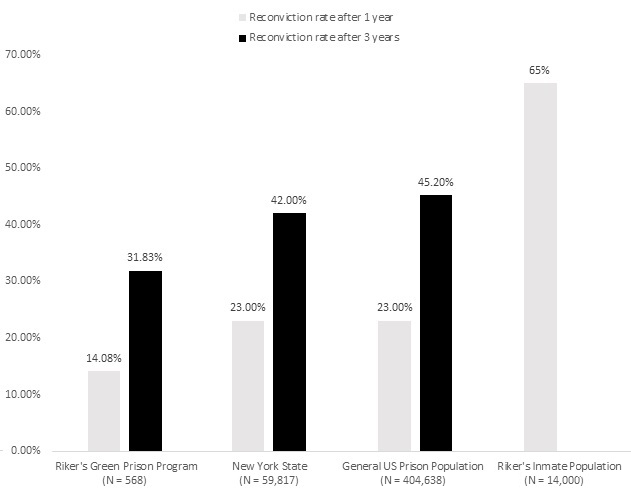Environment
The Rise of Green Prison Programs
How Exposure to Nature is Reducing Crime
Posted August 16, 2015

The United States has the largest prison population in the world. At present, over 2 million American adults are incarcerated in federal and state prisons. Aside from having the world's largest prison population, recidivism rates in the United States are astounding. According to the Bureau of Justice Statistics, on average, two-thirds (68%) of prisoners are re-arrested within 3 years of their release and 77% are re-arrested within 5 years of release. This is not just a recent trend, in fact, these numbers have changed little over the last 30 years. Just last month, President Obama visited the El Reno Prison in Oklahoma (the first sitting President to ever visit a federal correctional institution). After his visit, the President called for a full "prison reform".
In the 1970's, an influential report was published that evaluated the findings of over 200 correctional treatment studies (known as the "Martinson Report") and essentially concluded that "rehabilitation does not work ". In the report, Martinson begs the question; surely, prisons that institute rehabilitation programs have better outcomes than those who simply let their inmates rot? He eventually concluded that perhaps "education at its best, or psychotherapy at its best, cannot overcome, or even appreciably reduce, the powerful tendencies for offenders to continue in criminal behavior". This report had a profound and long-lasting impact on policy-makers, correctional practitioners and even the public at large. So does this mean that we should simply give up on our prison population?
Not quite. Since the 1990's, the United States has witnessed the growth of so-called "green prison" programs. Green prison programs essentially provide a form of nature-based therapy to prisoners under the guidance of trained professionals. Prisoners typically engage in gardening and horticultural activities, such as landscaping, cultivating plants, green roof gardening, learning about environmental stewardship and caring for nature and animals. Although variations exist, green prison programs often combine gardening activities with vocational education, practice mindfulness and teach prisoners social skills, such as how to work effectively with others in groups. Prominent examples include the Greenhouse/GreenTeam (GH) programs in Riker's Island, NYC, the Insight Garden Program (IGP) run in the San Quentin and California State Prison-Solano, CA, the Garden Project in San Francisco, the Ohio Green Prison Project and the Sustainability in Prisons initiative administered in prisons throughout Washington State.
In a new study published in the journal Criminal Behaviour and Mental Health, I assess the effectiveness of one of the countries' largest prison garden initiatives; the Greenhouse/GreenTeam program(s) in Riker's Island. Riker's is located on an island along New York's East River and is notorious for being one of the countries' largest and most abusive and violent prisons. Since the mid-90's, the Horticultural Society of New York has managed the program in collaboration with the NYC Dept. of Correction.
One way to evaluate the efficacy of such programs is to compare the 1- and 3-year re-convinction rates of prisoners released from the green program to a reference group, such as the average re-convinction rate(s) of prisoners released during the same period in New York State as a whole. We can also compare the results of the green program to the national numbers and to the average re-convinction rate of Riker's general inmate population. Have a look at the Figure below:

It is not difficult to spot the difference; the number of prisoners re-convincted after their release is substantially lower for graduates of the green prison program (over 10% lower compared to the state and national averages and drastically lower compared to Riker's long-term average). These differences are statistically meaningful by any stretch of the imagination. Recidivism can be calculated in different ways (e.g., number of re-arrests vs. actual reconvinctions). To be conservative, I compare actual reconvinctions here (the state and national averages for rearrests are much higher). These findings not only ring true for Riker's program. Indeed, other green prison initiatives such as the Insight Garden Program (IGP) have reported even lower recidivism rates.
So what is driving the success of green prison programs?
Prison environments are often bleak, overcrowded, chaotic, and isolating. Garden programs offer an opportunity for relief from such harsh social environments. Long-standing research in psychology and neuroscience has consistently shown that nature is restorative; even brief exposure to the natural environment can improve physical and mental health. For example, experiencing nature can improve cognitive functioning, lower stress and blood pressure and boost psychological well-being. A recent analysis of nearly 250 studies found that nature-assisted (NAT) therapy was effective in treating not only a variety of mental illnesses but also in treating physical pain. In fact, research in prisons has shown that -everything else being equal-, cells with window views of nature tend to have fewer prisoner sick calls.
Exposure to nature has also shown to promote cooperative behavior and pro-social values. Interviews with (former) green prison program participants have revealed that gardening programs promote self-esteem and feelings of purpose and self-worth, which in turn, makes prisoners feel less anxious, less depressed and less aggressive. The opportunity to take care of a living organism, witness its growth and see hard work come to fruition instills a sense of responsibility and achievement, it also promotes empathy and teaches prisoners valuable skills that they can use for life after prison.
Of course, simply comparing general recidivism rates does not provide direct causal evidence for the effectiveness of green prison programs, nor does it tell us specifically what aspects of the program are driving the results or whether they are more effective than other programs, for that matter. Yet, some experiments have shown that when randomly assigned to either a "green" or "other" rehabilitation program, the green program was significantly better for reducing risk-taking behavior, cultivating better decision-making skills and improving overall psychosocial functioning.
Now let me pitch the rough idea behind our prison system to you in slightly more provocative terms; let's imagine an individual who's spiraled down a path of bad decision-making, probably has some inclination for violence, aggression and a history of abuse and criminal conduct. Let's then decide to place this person in an isolated compound with thousands of like-minded individuals with similar backgrounds.This way, they can form prison sub-cultures, engage in violent gang activities and bounce bad decision-making habits off of each other so that by the time they are paroled, they are more violent, more ill-intentioned and less hopeful than they were when they first arrived.
Are we surprised recidivism rates haven't changed much in the last thirty years?
The definition of insanity is doing the same thing over and over again and expecting a different result. Although there is still much to be learned about the effectiveness of prison garden programs, especially in the long-term, one thing is clear; green prison programs are on the rise and their results are incredibly promising. Exposure and access to nature might just be a cost-effective way of reducing crime and improving the mental health of our society's prison population.
Further reading
Annerstedt, M., & Währborg, P. (2011). Nature-Assisted Therapy: Systematic Review of Controlled and Observational Studies. Scandinavian Journal of Public Health, 39, 371-388.
Bratman, G.N., et al. (2015). Nature experience reduces rumination and subgenual prefrontal cortex activation. Proceedings of the National Academy of Sciences USA. doi: 10.1073/pnas.1510459112
Jiler, J. (2006). Doing time in the garden: Life lessons through prison horticulture. Oakland, CA: New Village Press.
Lipton, D., Martinson, R., Wilks, J.(1975). The effectiveness of correctional treatment: A survey of treatment evaluation studies. New York: Praeger.
MacKerron G., & Mourato, S. (2013). Happiness is greater in natural environments. Global Environmental Change, 23, 992-1000.
Moore E.O. (1981). A prison environment’s effect on health care service demands. Environmental Systems, 11, 17-34.
Rice J.S., & Lremy, L. (1998). Impact of horticultural therapy on psychosocial functioning among urban jail inmates. Journal of Offender Rehabilitation, 26, 169-191.
Selhub E.M., Logan A.C. (2012). Your brain on nature: The science of nature’s influence on your health, happiness and vitality. Ontario, CA: John Wiley & Sons.
van der Linden, S. (2015). Green prison programmes, recidivism and mental health: A primer. Criminal Behaviour and Mental Health, 25, 338-342.
Zelenski J.M., Dopko R.L., & Capaldi, C.A. (2015). Cooperation is in our nature: Nature exposure may promote cooperative and environmentally sustainable behavior. Journal of Environmental Psychology, 42, 24-31.




